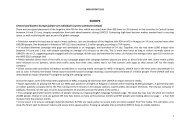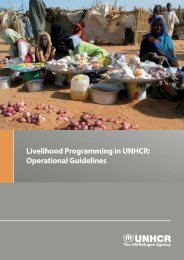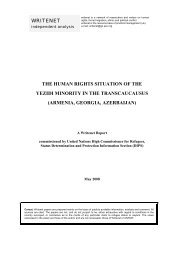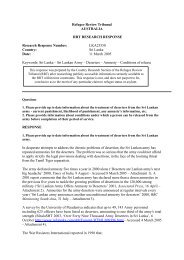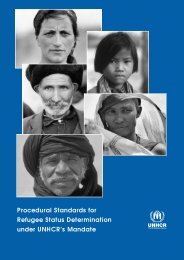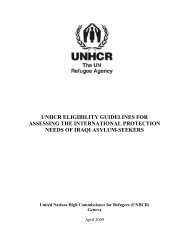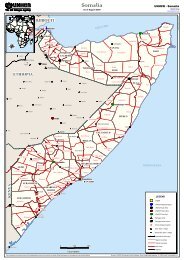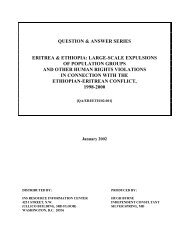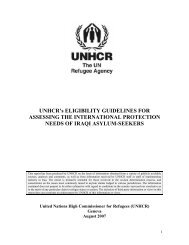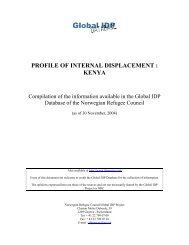CONCLUSIONS ADOPTED BY THE EXECUTIVE ... - UNHCR
CONCLUSIONS ADOPTED BY THE EXECUTIVE ... - UNHCR
CONCLUSIONS ADOPTED BY THE EXECUTIVE ... - UNHCR
You also want an ePaper? Increase the reach of your titles
YUMPU automatically turns print PDFs into web optimized ePapers that Google loves.
causes;<br />
2004 (Executive Committee—55 th Session)<br />
(iv) the strengthening of existing mechanisms to ensure that the necessary funds and other material<br />
and technical assistance are immediately made available;<br />
(v) the provision of support to host countries, especially developing countries, to assist the early and<br />
effective registration and documentation of refugees and asylum-seekers;<br />
(vi) the mobilization of adequate resources to support and assist host States in maintaining the civilian<br />
and humanitarian character of asylum, including in particular through disarmament of armed<br />
elements and the identification, separation and internment of combatants;<br />
(vii) the provision of support by the international community – agencies acting within their mandates –<br />
to host States in order to follow-up on those persons identified as falling within the scope of<br />
subparagraph (vi), including, where appropriate, the establishment of adequate mechanisms and<br />
special procedures for individual refugee status determination, including, inter alia, any possible<br />
application of the exclusion clauses of the 1951 Convention, for assessing claims of those<br />
combatants who have genuinely and permanently renounced military activities and seek asylum;<br />
(viii) the setting up of standby arrangements to allow for an immediate response to urgent security<br />
needs in countries of first asylum, including through the deployment of experts to help assure the<br />
security of refugee camps where appropriate and requested by the State concerned;<br />
(ix) the development of criteria and modalities for humanitarian transfer or evacuation to other<br />
countries, 2 fully consistent with international guidelines on the evacuation of children, 3 and<br />
financial assistance and other forms of support for the countries involved;<br />
(k) Acknowledges that the principles of international cooperation and solidarity in the context of mass<br />
influx situations and the approaches as set out in this Conclusion in particular in operative paragraph (g), are<br />
equally relevant to protracted refugee situations resulting from a mass influx and can contribute significantly to<br />
the sustainability of the international response; and highlights the importance in this respect of continued<br />
international engagement, including to resolve the causes of the mass influx in order to achieve durable<br />
solutions;<br />
(l) Notes the ongoing problems faced by countries of asylum, particularly those in the developing world,<br />
in coping with the consequences of mass influx situations once they have stabilized and particularly if they<br />
become protracted; and recommends that the following elements could be considered as part of the international<br />
response, including any burden and responsibility sharing arrangements that have been developed:<br />
(i) the evaluation, together with United Nations specialized agencies, non-governmental<br />
organizations and other relevant actors, of the impact of refugees on host country economies,<br />
society, environment and security, especially in protracted refugee situations;<br />
(ii) the review and updating, on a regular basis, of any comprehensive approach that may have been<br />
developed to address the mass influx situation;<br />
(iii) the advance pledging, where possible, of further financial or other assistance beyond the<br />
emergency phase until durable solutions are found;<br />
(iv) the provision of support for national protection capacities of host States as needed, inter alia, to<br />
strengthen registration and documentation systems, and establish national legal frameworks and<br />
other mechanisms required to enable protection and assistance to be assured over time;<br />
(v) the provision of financial and in-kind assistance in support of refugee populations and host<br />
communities to promote refugee self-reliance, as appropriate, thus enhancing the sustainability of<br />
any future durable solution and relieving the burden on countries of first asylum;<br />
(vi) the provision of financial and other forms of support, as appropriate, linked to broader economic<br />
developments and other concerns countries of first asylum may have in relation to providing<br />
protection to large numbers of asylum-seekers and refugees;<br />
(vii) the encouragement of international financial institutions to consider to what extent the economic<br />
2 In the context of the 1999 Kosovo crisis, the former involved the transfer of refugees to other States within the region,<br />
while the latter involved their evacuation to States further a field.<br />
3 ICRC, IRC, SCUK, UNICEF, <strong>UNHCR</strong>, WVI, Inter-Agency Guiding Principles on Unaccompanied and Separated<br />
Children, 2004, pp. 24–26; <strong>UNHCR</strong>, Refugee Children: Guidelines on Protection and Care, 1994, pp. 88–95; Evacuation of<br />
Children from Conflict Areas, Consideration and Guidelines, Everett M. Ressler, <strong>UNHCR</strong> and UNICEF, 1992.<br />
167




